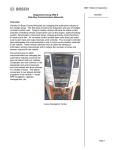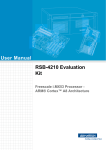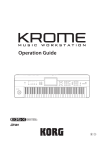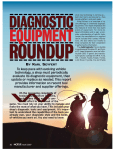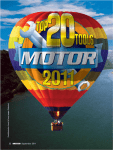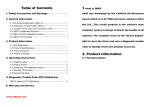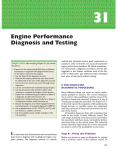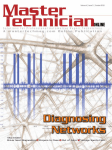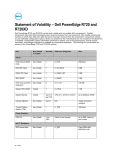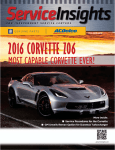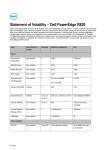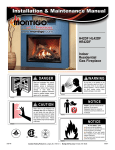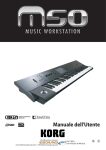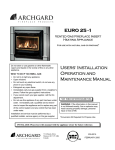Download "service manual"
Transcript
40 July 2007 Meddle With the Pedal: ELECTRONIC THROTTLE CONTROL BY MIKE DALE I t may well be that software integration of automotive electronic systems will turn out to be the most significant automotive technological development of this decade. Originally electronic systems such as ABS, HVAC and emissions were developed separately by those groups within each carmaker that were most responsible. The brakes and suspension group worked on ABS while emissions and engine control issues were handled by powertrain people. Software integration has brought these systems together. The result is new, interrelated technologies that produce better mileage, safer cars and reduced emissons. At the head of this trend, as an enabling technology, is electronic throttle control (ETC), which is part of an industrywide response to calls for better fuel economy, reduced emissions and a reduction in vehicular fatalities. This story is not so much about hardware as it is about software that uses ETC as an input and an actuator to make the new technologies possible. Without ETC, the planned advances in hybrid and diesel technology that are now right around the corner would not be possible. Cur- rent advances such as electronic stability control (ESC), expected to save thousands of lives per year, would simply not be possible without ETC. Best yet, ETC reduces cost and complexity for carmakers by integrating formerly stand-alone features such as idle control, cruise control and throttle control into a single, mostly software-based system. This latest version of electronic throttle control should not be confused with the earlier stand-alone systems that replaced the mechanical link between the driver and the engine. In these new systems, the output of the pedal sensor is an input not only to the engine control system but to the software system as a whole. As such, pedal angle becomes a valuable input to other electronic control systems. The algorithms that control the ABS, ESC, cruise control, HVAC and other system functions all use pedal angle data in the decision-making process. The throttle angle that results is not only what the driver wants but what the systems needs for correct and safe operation. In these new-generation ETC systems, the accelerator pedal module becomes a two-way device: It accepts information about desired engine output from the driver, plus it can feed back tactile information to the driver as a warning that the selected engine output is either wrong or dangerous. July 2007 Photoillustration: Harold Perry; Images: Mikuni Corp., Abletronik & Jupiter Images Doing away with the throttle cable was just the beginning. Electronic throttle control (ETC) has allowed engineers to add many other noteworthy vehicle systems and capabilities, with more to follow. 41 Photos courtesy Chrysler ELECTRONIC THROTTLE CONTROL This is the roller lifter used in Chrysler’s cylinder shutdown system. Oil flow regulated by a computer-controlled solenoid unlocks the lifter to prevent the valve from opening. The Technological Need for ETC The clear goals of the automotive industry are to improve fuel economy, reduce emissions and improve function and safety for the driver. To understand the design options available to accomplish these goals, you need to know what produces the best results and what causes subpar performance. These complicated goals are further complicated by trade-offs that have to be made. Fuel economy and emissions output per mile traveled are directly related to the size of the vehicle and the size of the engine. In keeping with the laws of physics, cutting fuel consumption is about either reducing the mass of the vehicle or reducing acceleration. Since the systems are not perfect, there’s another path that can be traveled—by improving efficiency to reduce losses. The first thing to know is that most automobile engines are much larger than they need to be for most real-world operating conditions. The big V8 often selected for full-size pickups is really chosen to pull a boat or trailer the owner may have in mind. Yet trailer towing may amount to less than 10% of the actual vehicle miles; 90% of the time a smaller engine would do just fine. The fact that engines generally spend most of the time running at a small fraction of their peak power output is referred to as the partial power problem. Toyota says the Otto cycle engine is most efficient at 40% to 45% of its redline rpm. This is the point at which torque is at about 70% to 80% of its peak value for a given engine. In this most efficient 42 July 2007 operating range, the engine produces about 40% of its peak power rating. Let’s use Toyota’s 108-hp ECHO engine as an example. Given the numbers just mentioned, it would be best if most of the time the engine output were in the range of 40 to 50 hp. Unfortunately, this is not enough for adequate acceleration or hill climbing. Calculations show that if the ECHO had only a 30-hp engine, it would need 30 seconds to accelerate to 60 mph. If such a vehicle were to encounter a 10% grade, it would slow down to 30 mph before it reached the top of the hill. On the other hand, only 15 hp or so is needed to maintain 60 mph on level roads, and even less power is needed for idling and low-speed travel. The net result is that the engine power output that was chosen for adequate passing and hill-climbing is larger than necessary for most of the operating circumstances of the vehicle. In addition, engines are seldom operated under the circumstances that would produce the best results for fuel economy and emissions output. For a typical engine with a redline of 5000 rpm, the sweet spot should be at about 2000 rpm. In practical terms, most engines actually operate in a much broader range between idle and 3200 rpm. There are the occasional zooms to redline, but they represent a small part of the true operational circumstances. Given normal gearing, the peak efficiency point for a vehicle turns out to be around 55 mph. The double-nickel speed limit was not chosen randomly, but rather with an eye to best fuel econ- omy for the average vehicle. For a given distance traveled, fuel economy tapers off at both higher and lower speeds. Holding a constant speed is an advantage, as it avoids both the extra fuel needed for acceleration and the increased emissions that often result from deceleration. Not surprisingly, the sweet spot of engine efficiency is also the sweet spot of emissions output. It’s the cold-start events and sudden speed changes that challenge emissions control systems. Electronic throttle control can actually help emissions through strategies that lean out the mixture in concert with retarded ignition timing to assure an earlier light-off for the converter. Efficiency losses occur on both sides of the sweet spot for a given engine. At high engine speeds, friction among the piston, the rings and the cylinders accounts for more of an engine’s lost output. These friction losses become more significant as engine size is reduced. Parasitic losses to engine accessories such as the oil and water pumps also increase as a function of rpm. Another issue is the need to richen the fuel mixture to get maximum torque output from the engine. It may help acceleration but it doesn’t help emissions output or fuel consumption. The major cause of efficiency losses at low speed is called pumping loss. Reducing the output of an engine is accomplished by limiting the airflow into the engine. The throttle plate restricts the intake of air by forcing the engine to drag air through a narrow or restricted inlet. The restriction of the air intake The black trace at the bottom of this screen capture shows how the MDS switches between four-cylinder and eightcylinder operation. At higher speeds the load is lower and the portion of the time in four-cylinder mode increases. creates a differential pressure across the throttle plate we know as intake manifold vacuum. Since the air entering the cylinder is below atmospheric pressure, less air enters the cylinder. The engine control system measures the pressure differential and reduces fuel input accordingly. The reduced quantities of air and fuel result in the desired reduction of power output. The downside to this is that having partial pressure in the intake manifold wastes energy. As the piston moves downward on the intake stroke, normal pressure below it and partial vacuum above it cause drag on the rotation of the crankshaft. These pumping losses occur during most engine operating conditions, as the throttle is seldom truly wide open. Diesel engines are known to be approximately 25% more efficient than gasoline engines. According to Toyota, one reason is that the diesel engine uses no throttle, and thus suffers reduced pumping losses. In gasoline engines, the throttle-related losses are believed to be in the range of 7% to 10%. Diesel engines are also more efficient due to their higher compression ratio. GM says that it’s difficult to achieve all of the design goals of better fuel economy, reduced emissions and driver safety at the same time. Typically, in a fixed-valve-timing engine, best power has be traded off against other desirable elements such as torque, idle stability and fuel economy. 44 July 2007 Photo courtesy Mikuni Corp. Waveform courtesy Chrysler ELECTRONIC THROTTLE CONTROL The stepper motors on these throttle bodies are mounted on the side. With direct computer control, the throttle angle can be changed to adapt the engine throttle setting in keeping with the results of the computer’s algorithm. There are other approaches that try to deal with the issue of the throttlerelated partial power problem. Gasoline direct injection is an approach to improving efficiency by calibrating each combustion event to the needed power requirements. The direct injection system controls engine power by injecting only that amount of fuel needed to produce the desired engine power output. Another approach is through variable valve timing. VVT systems offer varying degrees of control based on system complexity limits. Early intake valve closing (EIVC), late intake valve opening (LIVO), late intake valve closing (LIVC) and fully variable valve lift strategies have demonstrated reduced pumping losses and improved fuel economy. GM has tried the EIVC strategy, which uses the variable intake valve closing and intake valve lift control to unthrottle the engine at part-load and light-load operating conditions. Here the intake valve duration and lift are significantly reduced to control airflow into the engine, allowing it to operate at higher intake manifold pressures with the potential to fully unthrottle the engine under all operating conditions. Electronic or hydraulic valve actuation solenoids under the direction of software-controlled cam profiles may someday offer even greater flexibility. These systems have been talked about and demonstrated. Renault had one in a Formula One racer a while back with a 17,000-rpm redline. So far the software cam has not appeared in a production vehicle due to the dynamic complexity of landing the valve back on its seat without noise. The actuators shown so far are also bulky and expensive in comparison to mechanical actuation. According to GM, the downside to these various VVT strategies for production engines is that they require moderate to significant changes to the engine’s architecture to successfully package the VVT components. Cam phasers not only take up space, but also add to the vehicle in terms of complexity, weight and cost. Using ETC to Achieve System Goals Automakers have taken this research into engine efficiency and done their best to make sure the engine spends more of its time in and around the sweet spot. They know that the vehicle has to feel “normal” to the driver and have gone to great lengths to make that happen. From the driver’s standpoint, what the computing platforms are adjusting and controlling is strictly in the background. Getting greater efficiency is accomplished in several ways: Transmission Control. Keeping the engine at its rpm sweet spot is accomplished by having more of the need for rpm compensation between the engine and the drive wheels handled by the transmission. Six-, seven- and eightspeed transmissions, as well as CVTs, are becoming commonplace. As CVTs are still limited in their peak torque handling capability, vehicles with highoutput engines have stayed with conventional multispeed transmissions. Ford and GM are in production now on their joint venture six-speed transmission. About 85% of the components are meant to be shared by both manufacturers. Expectations are for a 4% increase in fuel economy while at the same time providing a 7% improvement in 0-to-60 times. Unlike conventional transmissions, with their ratio spread of approximately 4.0 to 1.0, the new Hydramatic/Ford transmission has a wider overall ratio of 6.0 to 1.0. Electronic throttle control is an integral part of the improvements in both fuel economy and acceleration. Having so many gears requires some adaptations. Toyota’s eight-speed transmission, for example, has a software provision to skip gears during deceleration to make the downshifting smoother and less apparent to the driver. The ETC system smoothes the shift performance between gears by adjusting the throttle opening at the shift point. Programmed steps in the ETC system can be used to give the driver the “feel” of a conventional transmission, so the CVT doesn’t feel odd. Driveline management software is used to select the combination of engine output and gear ratios that will deliver the needed torque in the most efficient way. The software is capable of reducing the torque input to the transmission during the shift sequence to reduce mechanical shock to the drivetrain. This driveline management software is especially important for on-demand AWD. The shift from two-wheel to four-wheel drive must be controlled to avoid torque bumps and other interactions between the drive wheels. Displacement Reduction for Light-Load Conditions. GM, Chrysler and others have implemented variable displacement strategies. GM’s Displacement on Demand system reduces effective engine size during steady-state, lowpower conditions. A key aspect of this system is the ETC system’s ability to create a greater throttle angle without the need for the driver to change pedal an- 46 July 2007 Photo courtesy Abletronik ELECTRONIC THROTTLE CONTROL What was once a simple pedal and spring arrangement has become a highly sophisticated sensor/actuator. Triple redundant systems assure that the driver’s intent gets to the computer without error. gle. This is a key element to assuring that the only indication to the driver that four of the V8’s cylinders are deactivated is the light on the dash. Emissions Control. ETC is a part of the strategy to reduce engine emissions during cold start-up. One way to cause quick heating in the catalytic converter is to retard timing and lean out the mixture. The ability to do this is limited by the loss of torque and power that results from these engine settings. For a given pedal position, the driver will feel reduced power when the strategy is implemented. Software compensations to the throttle angle can be made that maintain the original pedal-to-throttle relationship the driver is used to. ETC also can be used to control actual throttle angle during acceleration and deceleration to minimize pumping losses. Often the throttle angle implemented by the ETC system could be more favorable than the driver is able to select. The greatest impact on emissions performance of ETC systems is the above-mentioned variable displacement strategies. Cadillac’s first attempt at variable displacement (V-8-6-4) in the early ’80s foundered at the time for a variety of reasons, including driver dissatisfaction with how the engine “felt” as it dropped or picked up displacement. ETC, with its computer control, is able to automatically make the throttle angle changes needed so the change is seamless to the driver. Another benefit of ETC, according to GM, is the ability to modify vehicle response to a change in pedal angle position. Consumer research shows that vehicle response to accelerator inputs greatly affects a driver’s overall satisfaction with the vehicle. The response of the vehicle to the first 20mm (.8 in.) of throttle movement may be more important than the actual 0-60 acceleration time. Vehicle Safety. Electronic stability control is probably the most significant safety development since the invention of the seat belt. By federal requirement and automaker cooperation, this system will be standard on all vehicles by 2010. The hope is that as many as 10,000 lives per year will be saved. To function as it does, ESC depends on ETC. Electronic stability control systems are an integration of existing vehicle systems (ABS, TC, ECM), coupled with added sensors to determine steering angle and yaw. A key input to the system is the pedal angle position sensor output. The ESC system runs an algorithm that determines if the requested engine output is safe. When it’s advisable, the output from the system can be a throttle angle command that’s not what the driver requested. When there’s a possible loss of traction and/or steering control, the ESC system can overrule driver input to reduce throttle angle and engine power. Electronic throttle control can also be used to protect the engine, driveline and tires from operation that may cause excess wear or damage. Rev limiting can be accomplished in software by governing the throttle angle rather than cutting off fuel or ignition. This results in a much smoother limiting that does not cause the driver to sense that the engine has “cut out,” as can be the case with ignition- and fuel-based limiter systems. Rental car companies have The stepper motor positions the throttle plate according to the results of the computer’s throttle position algorithm. The gear train increases the resolution so the plate can be set with high accuracy. pushed for rev limiters as a way of protecting their assets from drivers who don’t care how hard they push a vehicle simply because they don’t own it. Using ETC to Enable Other Technologies GM’s Vortec 5.3L V8 uses Active Fuel Management (AFM), with ETC as a key input. The 3.9L V6 also uses AFM, but in combination with VVT. GM says the 3.9 is the first to use both cylinder deactivation and VVT on the same engine. Under light-load conditions, either engine can deactivate half the cylinders. Real-world fuel savings of 7% is what GM is advertising, although the benefit reportedly is greater for those who do a lot of steady-state highway cruising. The E38 ECM measures load conditions based on inputs from vehicle sensors such as ETC and interprets that information to manage more than a hundred engine operations. Fuel injection, spark control and electronic throttle control are all included. When loads are light, the engine computer automatically closes both the intake and exhaust valves, while at the same time cutting fuel delivery. When the driver demands acceleration or increased torque to move a load, the cylinders are reactivated. In these systems, ETC is used to balance torque to prevent the driver from “feeling” the cylinders as they come or go off-stream. During deactivation, both valves are closed. The energy used to compress the air in the cylinder is returned to crankshaft on the downstroke as the trapped air acts as a spring. The 48 July 2007 The dual and offset outputs from the pedal angle sensor are a form of redundancy that guarantees the accuracy of the output. Some pedal assemblies can feed back to the driver tactile information about the correctness of the desired throttle angle. transition takes less than 20mS, and the driver never notices it. The actual hardware used to control the deactivation is called a lifter oil manifold assembly (LOMA), and is located in the valley of the V8 engine. Four electric solenoids are controlled by the result of the E38’s processing of the load algorithm. These solenoids determine the number of active cylinders by controlling oil flow to the lifters of the affected cylinders. In an AFM-equipped engine, pumping losses are reduced during deactivation primarily by the increase in intake manifold pressure. During deactivation, the remaining cylinders need reduced throttling in order to provide an equivalent amount of work. Without electronic throttle control, the driver would notice the deactivation as a sag in performance. Without the driver needing to change the pedal angle, the software changes the throttle angle to reflect the fewer number of functioning cylinders. AFM operation is load-based. The load is measured and combined in an algorithm with the driver’s demand for power as measured by throttle application. Active fuel management does not affect emissions output from the active cylinders. For the inactive cylinders, no fuel is wasted or burned, and the result is lower emissions for the distance traveled. The key point here is that the only mechanical components needed are the three or four special valve lifters and the solenoids to control them for the cylinders that are to be deactivated. The software-based control system uses inputs about engine load, vehicle speed, driver intention, safety and emissions inputs in making the decision to shut down individual cylinders. The ETC system already in place is used to make sure the vehicle operates “normally” during the deactivation. The Gen IV Vortec 5.3L takes ETC to the next level by taking advantage of the processing capability available in the E38 computer. The increased integration allows the elimination of the throttle actuator control (TAC) module. In previous systems, the TAC module took commands from the ECM and operated the electric stepper motor that controls throttle position. In the new system, the ECM operates the throttle directly. This direct link between the throttle and the computer speeds up response time. Eliminating the TAC also reduces wiring, reliability issues and the need to monitor the TAC module for correct operation. The flex-fuel 5.3 requires no special fuel sensor. Earlier flex-fuel engines used a light-reactive sensor to determine what blend of fuel was in the system. The Gen IV engine uses a virtual sensor programmed into its software. Based on readings from the oxygen sensors, fuel level sensor and vehicle speed sensors, the ECM determines the fuel blend and adjusts the fuel injector pulse width and the throttle angle as required. The ETC system makes the needed throttle angle changes. Because ethanol has a lower BTU rating for the same volume as gasoline, more fuel is required to provide the same power at wide-open throttle. Illustrations courtesy University of Toyota ELECTRONIC THROTTLE CONTROL ELECTRONIC THROTTLE CONTROL Toyota is using what it calls Power Train Management on the Lexus LS 460. With this system, the most suitable vehicle drive power is accurately accomplished with optimized engine torque and gear ratio. Toyota’s emphasis is on what the driver experiences, which is torque at the drive wheels. Toyota says that with conventional powertrain controls, a target throttle opening and gear ratio are determined according to the driver’s pedal angle input. Consideration in terms of throttle angle is given to other vehicle systems such as cruise control and vehicle stability control (VSC). The result is that the Circle #27 Circle #28 Circle #29 Circle #30 50 July 2007 target throttle opening and target gear ratio are set separately. In previous systems, this situation worked well because each of the vehicle systems was not large, and the desired accuracy requirements were not particularly high. This situation has changed. Newer vehicle systems with precrash safety systems and intelligent parking assistance (IPA) systems have caused the relationships among vehicle systems to become more complicated. It has become more difficult to align all the different systems to achieve the desired drive power. Toyota says it has developed something called Vehicle Dynamics Integrated Management (VDIM) to integrate the vehicle stability control, traction control, ABS and electric power steering. ETC is used for VDIM sensor inputs and control actuators. The VDIM system controls the “drive power” by selecting the combination of engine power and transmission gear to give the needed drive wheel torque at the highest possible efficiency. By having an integrated system, the best choices for ignition timing, engine rpm and gearing can be chosen to deliver torque and acceleration the driver senses. The torque and power of the drivetrain for hybrid vehicles can come from the internal combustion engine, the generator and/or the electric motor. Combining and distributing the torque is handled by a planetary gearset that both Toyota and Ford call a power split device (PSD). In the PSD, the carrier gear is connected to the engine, the sun gear is connected to the generator and the ring gear is connected to the electric motor. The planetary gear configuration provides decoupling of engine speed from vehicle speed. While a hybrid drivetrain offers the possibility of improved fuel economy, there are some added constraints. Ford says one issue is that power split vehicles are sensitive to such noise factors as engine torque mismatches that conventional vehicles are not. These systems are also sensitive to overuse of the battery that may affect its durability. To overcome these issues, Ford Escape/Mercury Mariner engineers had to determine powertrain operating points compatible with the battery and high-voltage bus architecture to ensure that power, voltage and durability issues were met. Ford says that the determination of a desired powertrain operating point for a conventional vehicle is relatively straightforward, since there’s only one path to the wheels from the power-generating device (the engine). There are three variables that need to be determined—the transmission gear, the torque converter clutch state and the desired engine torque. The driver’s intent is reported by the pedal angle sensor. The gear and torque are determined by computer algorithm, with the result that the throttle angle is controlled. In a hybrid vehicle, there are three power-producing devices—the generator, the motor and the engine. The control system determines what the driverdemanded wheel torque is by way of the pedal angle sensor. From this, the computer software can choose the optimum combination of desired engine speed and desired wheel torque. Engine speed is the result of the throttle position algorithm’s control of the throttle angle. Wheel torque is the result of the choice of power sources and the gearing between them and the wheels. In the power-split hybrid electric vehicle, generator torque and generator speed—and, therefore, generator power—are largely determined by the desired engine speed and actual engine torque. So the battery power limit is essentially a constraint on motor power. Since motor speed is determined by vehicle speed, this effectively limits motor torque. Motor torque is also limited by what the driver wants in terms of driveability. The hybrid control system has to manage the interactions of the three possible power sources. Electronic throttle control integrated into the system is used to accept the input of the driver and to then control the engine’s output in accordance with the other two sources of power. At the heart of the hybrid control system described by Ford is the electronic throttle control system and its ability to accept driver input and then output a throttle angle position in keeping with the best interests of the whole system. It’s the integrated software of the transmission and engine control systems that gives the system response. To sum up, what started out as a means of eliminating the mechanical connection between the throttle pedal and the engine has evolved and taken on a larger and far more important role. By integrating the safety, emissions and powertrain electronic subsystems, it has become possible to implement new technologies that could not have been implemented independently. Electronic throttle control is a mandatory element of these advanced systems. Visit www.motor.com to download a free copy of this article. Circle # 31 July 2007 51 OBD II Network Diagnostics Diagnostics Using OBD II Data Bus Communication Networks NOTES: Overview: Vehicle On-Board Control Modules are changing the automotive industry in two related areas. The first area concerns the expansion and use of multiple on-board control units. Today’s modern vehicle will have on-board control modules controlling vehicle components such as the engine, antilock braking system, transmission, instrument panel, chassis and body control functions, to name just a few. An on-board control module does more than just make sure its own input and output devices work correctly. The on-board controller also participates and communicates in one or more communication networks in the vehicle. These vehicle networks exist to allow the sharing of information among components and to reduce the numbers of wires and sensors required in the vehicle. The second area in which microcontrollers are changing the automotive industry concerns the way we interact with our vehicles. Computers are now common in the passenger area and consumers can now interact with their vehicles in a variety of ways. This allows consumers to run already familiar programs in the vehicle — email, GPS navigation, calendar management, etc. Lexus Navigation Center Page 1 OBD II Network Diagnostics NOTES: The second phase of this migration also allows the automotive technician to interact with the vehicle’s on-board controllers, gathering information, controlling the vehicle directly and aiding in the diagnosis of problems. This interaction can occur with the use of a scan tool or in some case accessing the on-board controller directly through an operation sequence or a control panel on the vehicle. 2005 Dodge Neon with Idle Air Control Motor DTC (P0508). This code was obtained by cycling the ignition key on/off three times. Notice how the code is displayed directly on the dash panel. KTS 200 Communicating with Generic OBD II interface. Robert Bosch LLC Network and Scan Tool Communication: An automotive controlled network consists of multiple series of control modules electronically communicating complex information and requests in a digital language format. This digital language is known to technicians as “vehicle protocols”. Modules can be connected on the network in serial or parallel interface. The term used for this type of communication interface is called “Multiplexing” and can be carried through single or dual circuits. When a scan tool is connected and interfaced into the network it should be considered as one other control module on the network. Page 2 OBD II Network Diagnostics Primary Purposes of Networking: NOTES: One of the major driveability concerns in automotive diagnostics is circuit related problems due to bad connections creating opens, shorts, resistance and voltage drop problems. Networks help resolve these problems by eliminating miles of wires, connections and splices. With networking, a fuel pump circuit that would normally be wired to the PCM to be commanded on could now be wired to a Rear Control Module (REM) reducing wire length and potential circuit problems. With networking, the command from the PCM to turn on the fuel pump could be sent to the REM module over the network that would then activate the fuel pump circuit. Note: As networks evolve look for control modules to be located in various quadrants within the vehicle and components located near that quadrant reporting to a specific control module. 2004 Volvo S 80 Control Module Network Configuration. Circuit Diagram from CAS/SIS Diagnostics ESI[tronic] Robert Bosch LLC Page 3 OBD II Network Diagnostics NOTES: Network Topology: Linear: Interconnection of multiple ECU’s on common linear bus. A multi-master principle is generally used, allowing high stability with enhanced fault localization. This system is used in drivetrain and body network systems. Ring: Short path interconnection of multiple ECU’s in a fiber-optic series ring. The information passes through each ECU. This system is used in multimedia networks. Multimedia systems require large volumes of data to be transferred in short amounts of time. To transmit a digital TV signal with stereo sound requires a data transfer rate of around 6 Mbit/s. MOST (Media Oriented Systems Transport) can transfer data at a rate of 21.2 Mbit/s. Star: Interconnection of multiple ECU’s in a star structure network control by central master ECU. This system uses a master-slave, time triggered protocol. The network is designed as a low cost, local sub-system single wire interconnect network for use in on-off devices such as car seats, door locks, sunroofs, rain sensors and door mirrors. Terminating Resistors: Terminating resistors are used in CAN systems to create proper electrical load between the CAN_H and CAN_L circuits. This load helps to reduce electrical noise on the data circuits, which allows for a cleaner voltage signal on the data bus. Terminating resistors in the high speed CAN systems are required to be 120 ohms with a maximum range of 118-132 ohms. Lower speed CAN systems may use different values. CAN systems can use split termination, which means there may be more than two terminating resistors in the system. Terminating resistors may be physically located inside any of the control modules connected to the CAN harness, with a junction connector. The resistors may also be part of the wiring harness. Terminating resistors may or may not be identified in circuit wiring diagrams. Do not attempt to conduct wiring diagnostic fault procedures such as voltage or resistance tests without proper service information. The figure on the next page shows an example of a CAN system with terminating resistors. Page 4 OBD II Network Diagnostics NOTES: Signal protocols: There are five basic signal protocols currently in use with the OBD-II interface. SAE J1850 PWM SAE J1850 VPM ISO 9141-2 ISO 14230 KW ISO 15765 CAN (C&B) Pin # Pin Assignment 1 Pin # Pin Assignment 9 2 SAE J1850 (SCP Bus +) 10 SAE J1850 (SCP Bus -) 3 ISO 15765-4 CAN MS (Bus +) 11 ISO 15765-4 CAN MS (Bus -) 4 Chassis Ground 12 5 Signal Ground Return 13 6 ISO 15765-4 CAN Hi (Bus +) 14 ISO 15765-4 CAN Low (Bus -) 7 K Line of ISO 9141 15 L Line of ISO 9141 16 Fused Battery Power 8 Page 5 OBD II Network Diagnostics NOTES: J1850 from the Society of Automotive Engineers Protocols: Ford “Standard Corporate Protocol”: Protocol operates at 41.6 kB/sec with two wires on the bus. _ SAE J1850 PWM (41.6 kbaud, standard of the Ford Motor Company) _ Pin 2: Bus_ Pin 10: Bus+ _ High voltage is +5 V SAE J1850 PWM MTS 5100 Robert Bosch LLC Page 6 OBD II Network Diagnostics General Motors Class 2 Bus: NOTES: Protocol operates at 10.4 kB/sec with one communication wire. Chrysler also has an adaptation of the GM Class 2 protocol. _ Pin 2: Bus+ _ Bus idles low _ High voltage is +7 V _ Decision point is +3.5 V _ Message length is restricted to 11 bytes, including CRC SAE J1850 VPM ISO 9141-2 from the European-influenced International Standards Organization: This is a single-wire where the ISO modules talk only when asked and only to the scan tool, not to each other. This protocol is slower than GM and Chrysler versions of SAE J1850. The ISO 9141-2 protocol has a long wake-up call which allows for each control module to report PID data. ISO 9141-2 protocol has a data rate of 10.4 kbaud and is primarily used in Chrysler, European and Asian vehicles. Page 7 OBD II Network Diagnostics NOTES: _ Pin 7: K-line _ Pin 15: L-line (optional) _ UART signaling (though not RS-232 voltage levels) _ K-line idles high _ High voltage is Vbatt Just because a vehicle has an ISO protocol does not mean that the control modules are unable to talk to each other. An example would be a 2001 Volkswagen Passat where the modules talk to each other on a CAN protocol network. The CAN protocol is then transmitted to the IP instrument cluster module where the signal protocol is converted to ISO format for communication with the scan tool. ISO 9141-2 ISO 14230: In use by 1997, ISO 14230 was an upgrade to ISO 9141-2. One of the major enhancements of ISO 14230 was a faster wake-up call. _ ISO 14230 KWP2000 (Keyword Protocol 2000) _ Pin 7: K-line _ Pin 15: L-line (optional) _ Physical layer identical to ISO 9141-2 _ Data rate 1.2 to 10.4 kbaud Page 8 OBD II Network Diagnostics CAN Systems: NOTES: Controller Area Network (or CAN) is the latest communication system within the automotive world. CAN is a means of linking all of the electronic systems within a car together to allow them to communicate with each other. As on-board computers increase, so does the number of different electronic systems. Today’s modern vehicles may have as many as 50 or more on-board computer systems on them. The information recorded and processed by each control module is often used by one or more control modules on the system. A requirement for a standardized means of quickly passing information between the control modules was needed leading to the development of CAN. CAN History: CAN protocol was created in 1984 by Robert Bosch Corporation with anticipation of future advances in on-board electronics. The first production application was in 1992 on several Mercedes-Benz models. CAN is now being used on more and more new vehicles. By 2008, all new vehicles sold in the U.S. will be required to have a CAN-compliant diagnostic system. CAN Protocols: ISO 15765 (CAN-B&C) CAN-B, the medium-speed network (nominally about 125 kB/sec), will be used for body electrical systems and normally will operate at 83.3 kB/sec. On some Mercedes cars, there may be as many as 30 modules on the CAN-B bus. _ Pin 3: CAN High _ Pin 11: CAN Low CAN-C is a 500 kbit/s high speed two-wire system for powertrain, transmission and ABS modules. CAN-C is intended to operate at a 500 kB/sec baud rate, about 50 times faster than GM's Class 2 data bus version of J1850 and over 60 times faster than ISO 9141-2. _ Pin 6: CAN High _ Pin 14: CAN Low Note that Pins 4 (chassis ground), 5 (signal ground) and 16 (battery positive) are present in all configurations. The next page shows a CAN_High and CAN_Low waveform. Page 9 OBD II Network Diagnostics NOTES: Screen Capture using KTS 570 lab scope Robert BoschLLC Internal CAN Communication: CAN networks can communicate internally, but not with the scan tool. Many CAN modules will talk with each other and a gateway; or translator module, will convert the protocol so a scan tool can understand it. CAN Translators VW Example: Instrument clusters from 08.99 > are integrated into the vehicle CAN Data Bus network. The CAN-Bus on-board diagnostic Interface “J533” (which is integrated into the instrument cluster) enables data to be exchanged between the vehicles CAN Data-Bus network and the Data Link Connector (DLC) “K-wire”. The CAN-Bus On-Board Diagnostic Interface “J533” has specific on-board diagnostic (OBD) capabilities that are accessed by using scan tool address word 19 – “Gateway”. The next page shows a network diagram of a VW Passat with three different networks. Page 10 OBD II Network Diagnostics NOTES: Volkswagen Passat showing four different networks CAN A: Comfort & Convenience Systems: • Low/med speed data of 1k bit/s to 20k bit/s • No real-time requirements • Single wire • Cost effective • Uses various protocols CAN D: Multimedia: • • Real time data 1M – 400M bit/sec Fiber-optic network protocol with capacity for high-volume streaming, include automotive multimedia and personal computer networking. The graphic on the next page shows a fiber-optic CAN_D network. Page 11 OBD II Network Diagnostics NOTES: CAN-B Audio Aux MOST Video line Lin CAN-D A Growing List of CAN Applications: Below is a list of some vehicles that are currently in CAN compliance. CAN compliant means that the CAN network broadcasts diagnostic information to the scan tool (Pins 6 & 14 or 3 & 11) in CAN protocol language. Many scan tools have to be updated with CAN module adapters to communicate at the higher baud rates that CAN systems produce. 2003 Ford Excursion 2003 Ford Focus and Thunderbird 2003 Lincoln LS 2003 Saab 9-3 2004 Cadillac CTS, XLR and SRX 2004 Ford Explorer 2004 Ford Taurus 2004 Mercury Mountaineer 2004 Mazda 3 and RX-8 2004 Volvo S40 2003 Ford F-250 and F-350 2003 General Motors Saturn ION 2003 Mazda 6 2004 Buick Rendezvous 2004 Dodge Durango 2004 Ford F-150, E-250 and E-350 2004 Lexus LS430 2004 Mercury Sable 2004 Toyota Prius 2005 Audi A4 and A6 2005 Chevrolet Equinox 2005 Chevrolet Trailblazer EXT 2005 Dodge Dakota and Magnum 2005 Ford Escape and Expedition 2005 GMC Envoy ESV and XL 2005 Jeep Grand Cherokee 2005 Lincoln Town Car 2005 Pontiac G6, Grand Prix and GTO 2005 Mazda MPV and Tribute 2005 Saab 9-7X 2005 Cadillac STS 2005 Chevrolet SSR 2005 Chrysler 300C 2005 Ford E-150 2005 Ford Freestyle 2005 Isuzu Ascender 2005 Lexus LS400 and GX470 2005 Mercury Mariner 2005 Land Rover LR3 2005 Mercedes-Benz SLK350 2005 Toyota Avalon 2005 Buick LaCrosse, Rendezvous and Rainier 2005 Chevrolet Cobalt, Corvette and Malibu 2005 Mercury Grand Marquis, Montigo and Sable 2005 Ford Crown Victoria, Five Hundred, Focus and Mustang 2005 Toyota 4Runner, Sequoia, Tacoma and Tundra 2005 Volvo S60, S80, V50, V70, XC90 Page 12 OBD II Network Diagnostics Strategy Based Diagnostics NOTES: General Motors developed strategy-based diagnostics for their technicians and the diagnostic procedure can be used on all vehicle applications. • Verify the customer concern: A technician needs to know how the system is supposed to function normally before deciding that the system is malfunctioning. A thorough customer interview, or a diagnostic worksheet filled out by the customer, is necessary before troubleshooting can begin. • Preliminary checks: Operate the suspect system and evaluate its performance. Perform a thorough visual inspection of all components, including fuses, connectors, grounds and harness routing. This is also an ideal time to pull up the service history on the vehicle. • Perform published diagnostic system checks. If there is a published diagnostic procedure that will help you narrow down the cause of the problem, use it first. Note: This is the time to connect the scan tool and request diagnostic information from the control modules on the network. • Check for bulletins: If you have access to published service bulletins for the vehicle, search those for a possible fix. This can save time in the long run. You can also print safety bulletins for your customers at this point, as an added value. • Stored diagnostic trouble codes (DTC’s) and symptoms with no DTC's: If there is a hard trouble code, then follow the diagnostic procedure for the particular DTC. If you have a repeatable symptom, then use the Symptom Charts. Both these procedures will quickly help you narrow your diagnostic focus. • No published diagnostics: When there is no DTC stored and no matching symptom for the condition in the service manual, you will have to develop your own diagnostic process based on your understanding of how the circuit operates. This is the time when there is no substitute for advanced systems training. The graphic on the next page shows the diagnostic flow chart for Strategy Based Diagnostics. Page 13 OBD II Network Diagnostics NOTES: Verify the Customer Concern Expanded: Know how the vehicle systems operate, the driving habits of the customer and the environmental driving conditions. The figure on the next page shows a 2001 VW Passat Central Locking Module located in a pan below the driver’s seat. Mud and snow can leak into this box and short out the computer, thus killing the communication with the Scan Tool. At this time there is no TSB on this problem, but you can find information on the problem by browsing the Internet. Even though the Internet is a great resource for information, you should take the time to make sure the information is accurate by checking other websites. Note: Bosch does not support, promote, or endorse any websites other than its own company website (www.Bosch.com). Page 14 OBD II Network Diagnostics NOTES: Graphic captured from the Internet Perform published diagnostic system checks expanded: Connecting the Scan Tool: Is there power on Pin 16 to power-up the Scan Tool? Many OEM scan tools may not have internal batteries and will require Pin 16 to have power in order for the scan tool to communicate. Be aware that no power on Pin 16 may affect some aftermarket scan tools (consult your operator’s guide). Many times Pin 16 will not have power due to something as simple as a blown cigarette lighter fuse. Remember Pin 16 is Battery Power Un-switched. Many technicians panic when their scan tool doesn’t power up off the 16 Pin connector. In some cases the technician will think the computer or computer(s) are dead and not communicating with the scan tool. A quick work around is to power up the scan tool through an alternate battery source or AC power source. Remember Pin 16 has nothing to do with communication, it is only there to power up your scan tool for diagnosis. Pins 4&5 are also important as one of these grounds will be needed for your Scan Tool to power up the OBD II link and establish a reference link for scan tool communication. If you are having communication problems it is imperative that you check the integrity of these grounds. In some instances one of these grounds may be open or have high resistance. There is also a possibility that the scan tool might complete a ground that is faulty when the scan tool is not connected. If the OBD connector has power or ground problems you should validate the connections when the scan tool is removed. Page 15 OBD II Network Diagnostics NOTES: Checking Power to Chassis Ground (KTS 570) Robert Bosch LLC Using the scan tool in conjunction with a 16 Pin Breakout Box: Different types of 16 Pin breakout boxes are available in the aftermarket. Some breakout boxes hook up in parallel, allowing you only the ability to probe the circuit with a scope or DVOM. Other breakout boxes like the AES LineSpi, hook in a series circuit, allowing the scan tool to command data bus protocols from the on-board computer while diagnosing with a lab scope or DVOM. AES LineSpi, MTS 5200, MTS 3100 connected to Ford ISO 9141-2 in Module Status Check. (www.aeswave.com) Page 16 OBD II Network Diagnostics What Computers Are Talking on the Network? NOTES: When diagnosing vehicle driveability problems with networked computer modules, know what computers are on the network for the particular vehicle application you are working on. Many vehicle applications may add or delete computer modules based on the amount of accessories and options. Most electronic information systems will have a computer network schematic at the beginning of the wiring diagrams section. Ford Motor Company Network Schematic (Ford Technical Publications) http://www.fordinstallersupport.com/ The Invention of the “U Code”: “U” codes were classified by the SAE as the 4th item for trouble code descriptions. In the early years of OBD II the “U” designation was classified as undefined. “U” codes are becoming more prevalent on today’s modern vehicles adding more advanced on-board diagnostics. Control modules are now programmed to know what other modules they should be in communication with on the network. Based on network communication problems, a “U” code could be set if a particular module was not communicating on the network. Flash reprogramming new control modules is necessary because new control modules need to know how that particular vehicle is configured in order to perform their function on the network properly. • The first character identifies the system related to the trouble code. − − − − P = Powertrain B = Body C = Chassis U = Network (for years “U” was undefined) Page 17 OBD II Network Diagnostics NOTES: Example of Generic U-Codes: U0100 Lost Communication With ECM/PCM “A” U0101 Lost Communication With TCM U0102 Lost Communication With Transfer Case Control Module U0103 Lost Communication With Gear Shift Module U0104 Lost Communication With Cruise Control Module U0105 Lost Communication With Fuel Injector Control Module U0106 Lost Communication With Glow Plug Control Module U0107 Lost Communication With Throttle Actuator Control Module U0108 Lost Communication With Alternative Fuel Control Module U0109 Lost Communication With Fuel Pump Control Module U0110 Lost Communication With Drive Motor Control Module U0111 Lost Communication With Battery Energy Control Module “A” U0112 Lost Communication With Battery Energy Control Module “B” U0113 Lost Communication With Emissions Critical Control Information U0114 Lost Communication With Four-Wheel Drive Clutch Control Module U0115 Lost Communication With ECM/PCM “B” U0116 Reserved by Document U0117 Reserved by Document U0118 Reserved by Document U0119 Reserved by Document U0120 Reserved by Document U0121 Lost Communication With Anti-Lock Brake System (ABS) Control Module Example of GM Manufactured Specific “U” Codes: U1000 U1001 U1002 U1016 U1016 U1017 U1026 U1027 U1040 U1041 U1042 U1043 U1056 U1057 U1161 Class 2 Communication Malfunction U1254 - Loss of XXX Communications U1015 - Loss of serial communications for Class 2 devices Loss of Class 2 Communication with VCM Loss of Communications with PCM U1025 - Loss of serial communications for Class 2 devices Loss of ATC Class 2 Communication U1039 - Loss of Serial Communications for Class 2 Devices Loss of Class 2 Communications with ABS Loss of EBCM Communication Lost Communications with Brake/Traction Control System U1055 - Loss of Serial Communications for Class 2 Devices Loss of Communications with RSS\ U1060 - Loss of Serial Communications for Class 2 Devices Loss of PDM Serial Data Bosch Diagnostics conducts courses on this subject as well as many other topics in the field of automotive and diesel technology. For more information on courses in your area, go to www.boschtechinfo.com or call (800) 321-4889. Page 18


























